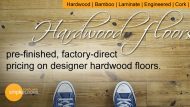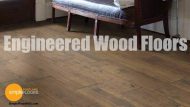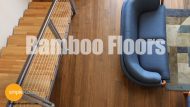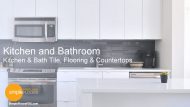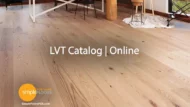Engineered wood uses the best parts of wood in a very sustainable and efficient way. One major downside to hardwood floors is that you cannot get the wood wet unless you have proper sealing. Without proper sealing, and sometimes even with it, hardwood absorbs the water and warps.
Engineered wood is more water-resistant, insulated, and a great choice if you’re concerned about living with a lighter carbon footprint.
4 Environmental Reasons To Buy Engineered Wood
As we mentioned in 5 Considerations When Picking Engineered Wood Flooring, it’s often difficult to tell engineered and hardwood floors apart Their color selections, style choices, and grains are nearly mirror images to one another. However, engineered wood has several advantages. Here are 4 of the advantages of picking engineered wood:
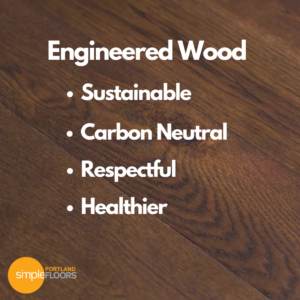
It’s Sustainable
Overall, wood production has become more sustainable using sound ecology principles with increasing forest areas and enhanced replanting. These increased forests have been producing more oxygen as well.
Engineered wood is a fantastic choice to have a natural home that has a small carbon footprint. And engineered wood can use up most of the tree.
It’s Carbon Neutral
Wood consumes fewer fossil fuels than steel or concrete. And trees clean the air making them carbon neutral.
And while natural wood is sustainable, it can take 60 years for a tree to grow back. That’s why engineered wood can be a better option.
It’s Respectful
Engineered wood can use up more of the tree. Standard wood planks are traditionally 2x10s or 2x12s. Plus, standard wood planks need to be milled from trees of a certain size. Manufactured wood uses up the smaller pieces of wood and wood particles combined with low-toxicity adhesives.
And whatever can’t be put into the engineered wood can be used for fuel for producing electricity or heat. Engineered wood uses 90% of the tree, and you can use smaller trees or parts of trees making it very eco-friendly.
It’s Healthier
Engineered wood is healthier for you than some laminates, vinyl, and bamboo flooring because it uses low-toxicity glue during the manufacturing process.
Other Reasons To Consider Engineered Wood
Why is engineered wood flooring so popular? Not only is engineered wood flooring beautiful, but it’s easy to maintain. You don’t have to worry about it getting dented and scratched like hardwood. And you don’t have to worry about it getting ripped like linoleum and laminates.
Engineered wood is also stronger and stiffer than the wood that’s used to create it. Creating wood by bonding together wood strands, veneers, and lumber has actually been around for about one hundred years. The grandfather of engineered wood is plywood.
Improved manufacturing processes have allowed the creation of wood I-beams, structural composite lumber and panels, and flooring.
Can It Get Wet?
This is everyone’s greatest concern because you want to avoid warping like what can happen with hardwood and some laminate flooring. It’s important to read all the information that comes with your floors and have a clear understanding of how your particular engineered wood floors should be maintained.
You may find that regular sweeping or using a stick vacuum is all you need to take care of dust, dirt, and animal hair. If something spills, wipe it up right away. You may find you never need to mop.
Engineered Wood Certifications
By now, you might be sold on engineered wood. The next step is understanding the certifications for engineered woods. They all determine how much volatile organic compounds (VOCs) are emitted like formaldehyde and phthalates. Here are the major 3:
FloorScore
FloorScore is a hard surface flooring (including adhesive) certification ensuring the product meets strict indoor air quality requirements. It tests for 35 separate VOC emissions including formaldehyde.
It was created by the Resilient Floor Covering Institute (RFCI, www.rfci.com) in collaboration with Scientific Certification Systems. Inspired by the California Department of Health Services Section 01350.
Indoor Air Advantage Gold
Indoor Air Advantage Gold certification is a VOC emission-based standard for indoor air quality. It’s often used with furniture but can certify flooring It doesn’t include phthalates because they’re not considered an emission source in furniture manufacturing.
To receive this certification, the manufacturer has its products tested at one of the certified labs around the world. This certification follows the LEED v4 standards. Developed by the US Green Building Council.
GREENGUARD Gold
GREENGUARD Gold is a certification through the Underwriters Lab that sets the standard with safety. They discovered that air pollution levels are 2-10x higher than those outdoors caused by the off-gassing of volatile organic compounds (VOCs) on products like furniture, flooring, paints, and much more.
To be GREENGUARD Gold certified, the product has to emit very low levels of VOCs. Most products like mattresses release the VOCs within the first few days, and it tapers off after that. Some items like electronics don’t have many VOCs until you turn them on. The heat produces pollution.
So, Is Engineered Wood Good for the Environment? Yes, engineered wood is sustainable and respectful of the environment. All sustainable products are green, but not all green products are sustainable. Wood can be replanted. And engineered wood uses unusual size wood as well as scraps. It has low pollution and is a terrific low-waste option.




